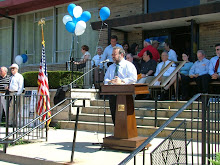LIVE THE JEWISH CALENDAR: MAY 14-15, 1948
ZIONISTS PROCLAIM NEW STATE OF ISRAEL : TRUMAN RECOGNIZES IT AND HOPES FOR PEACE
By Gene Currivan, Special to The New York Times
Tel Aviv, Palestine , Saturday, May 15 -- The Jewish state, the world’s newest sovereignty, to be known as the State of Israel, came into being in Palestine at midnight upon termination of the British mandate.
Recognition of the state by the United States , which had opposed its establishment at this time, came as a complete surprise to the people, who were tense and ready for the threatened invasion by Arab forces and appealed for help by the United Nations.
In one of the most hopeful periods of their troubled history, the Jewish people here gave a sigh of relief and took a new hold on life when they learned that the greatest national power had accepted them into the international fraternity.
Ceremony Simple and Solemn
The declaration of the new state by David Ben-Gurion, chairman of the National Council and the first Premier of reborn Israel, was delivered during a simple and solemn ceremony at 4 P.M., and new life was instilled into his people, but from without there was the rumbling of guns, a flashback to other declarations of independence that had not been easily achieved.
The first action of the new government was to revoke the Palestine White Paper of 1939, which restricted Jewish immigration and land purchase.
In the proclamation of the new state, the government appealed to the United Nations “to assist the Jewish people in the building of its state and to admit Israel into the family of nations.”
The proclamation added:
“We offer peace and amity to all neighboring states and their peoples, and invite them to cooperate with the independent Jewish nation for the common good of all. The State of Israel is ready to contribute its full share to “the peaceful progress and reconstruction of the Middle East .”
World Jews Asked to Aid
The statement appealed to Jews throughout the world to assist in the task of immigration and development and in the “struggle for the fulfillment of the dream of generations – the redemption of Israel .”
Plans for the ceremony had been laid with great secrecy. None but the hundred or more invited guests and journalists was aware of the meeting until it started, and even the guests learned of the site only ten minutes before. It was held in the Tel Aviv Museum of Art -- a white, modem-design two-story building. Above it flew the Star of David, which is the state’s flag; and below, on the sidewalk, was a guard of honor of the Haganah, the army of the Jewish Agency for Palestine .
Great crowds gathered and cheered the ministers and other members of the government as they entered the building.
The setting for the reading of the proclamation was a dropped gallery whose hall held paintings by prominent Jewish artists. Many of them depicted the sufferings and joys of the people of the Diaspora, the dispersal of the Jews.
The thirteen ministers of the Government Council sat at a long dais beneath the photograph of Theodor Herzl, who in 1897 envisaged a Jewish state. Vertical pale blue and white flags of the state hung on both sides.
At 4 P.M. sharp, the assemblage rose and sang the Hatikvah, the national anthem. The participants seemed to sing with unusual gusto and inspiration. The voices had hardly subsided when the squat, white-haired chairman, Mr. Ben-Gurion, started to read the proclamation, which in a few hours was to transform most of those present from persons without a country to proud nationals. Then he pronounced the words “We hereby proclaim the establishment of the Jewish state in Palestine , to be called Israel ,” there was thunderous applause and not a few damp eyes.
After the proclamation had been read, Mr. Ben-Gurion signed the document and was followed by all the other members of the administration, some by proxy. The last to sign was Moshe Shertok, the new Foreign Minister. He was roundly applauded.
The ceremony ended with everyone standing silently while the orchestral strains of the Hatikvah filled the room.
As the Sabbath had started, there was not the degree of public rejoicing that there would have been any other day. The proclamation was to have been read at 11 P.M., but was advanced to 4 because of the Sabbath.
In the preamble to the declaration of independence, the history of the Jewish people was traced briefly from its birth in the land of Israel to this day. The preamble touched on the more modern highlights, including Herzl’s vision of a state, acknowledgment of the Jewish national homeland by the Balfour Declaration in 1917, its reaffirmation by the League of Nations mandate and by the United Nations General Assembly resolution of Nov. 29, 1947.
Israel , the proclamation went on, will be open to immigration by Jews from all countries “of their dispersion.” She will develop the country for the benefit of all its inhabitants, and will be based on precepts of liberty, justice and peace taught by the Hebrew prophets.
The new state, will uphold the “social and political equality of all its citizens without distinction of race, creed, or sex” and “will guarantee full freedom of conscience, worship, education, and culture.”
The statement pledged safe-guarding of the sanctity and inviolability of shrines and holy places of all religions. It also contained a promise to uphold the principles of the United Nations.
There was great cheering and drinking of toasts in this blacked-out city when word was received that the United States had recognized the provincial government. The effect on the people, especially those drinking late in Tel Aviv’s coffee houses, was electric.
Wednesday, May 14, 2008
Subscribe to:
Post Comments (Atom)










No comments:
Post a Comment